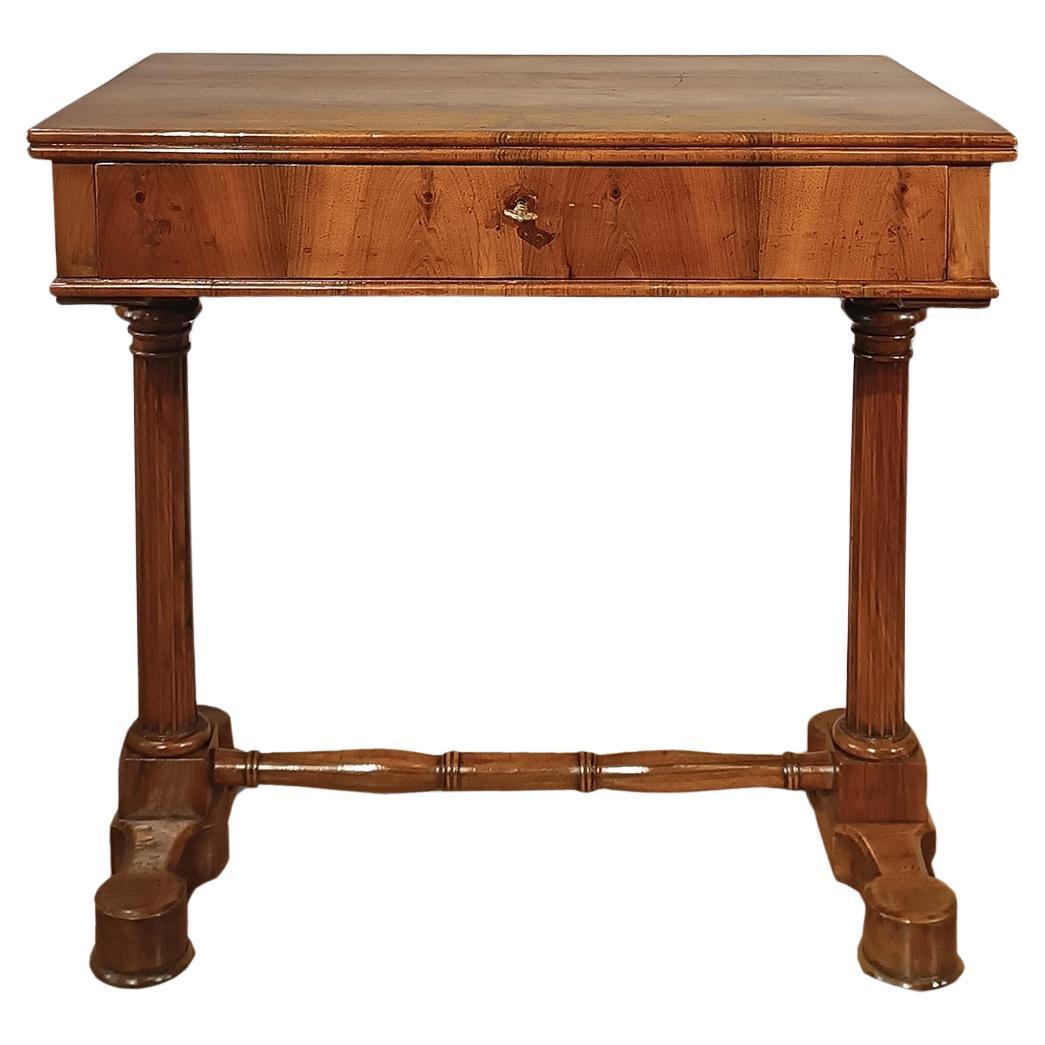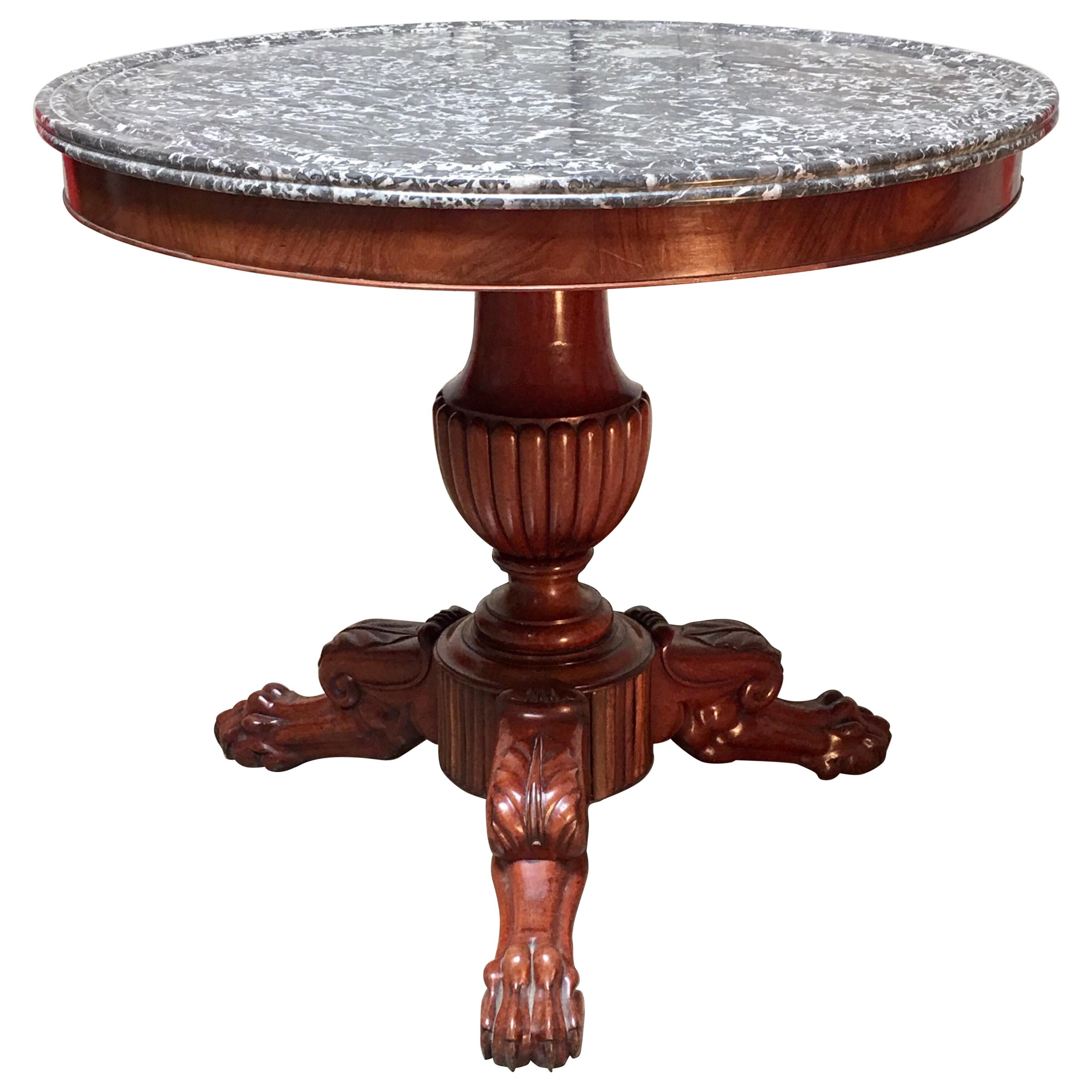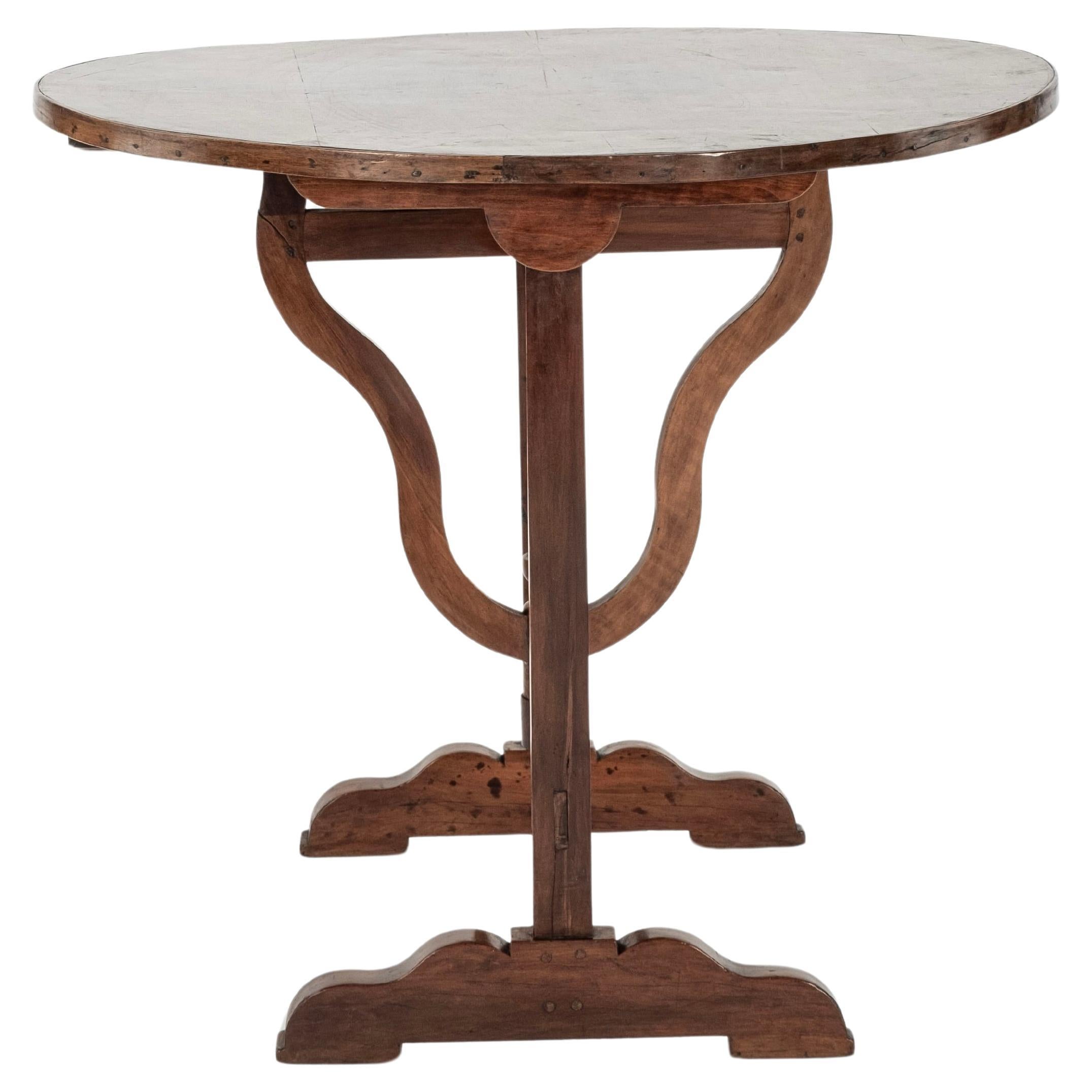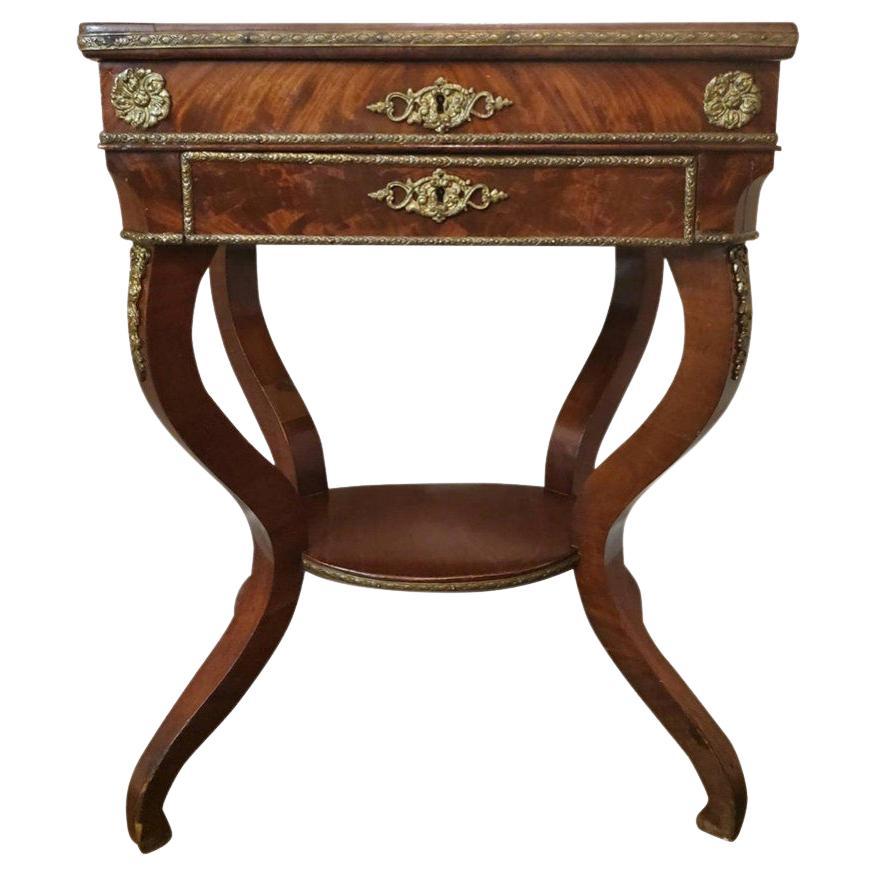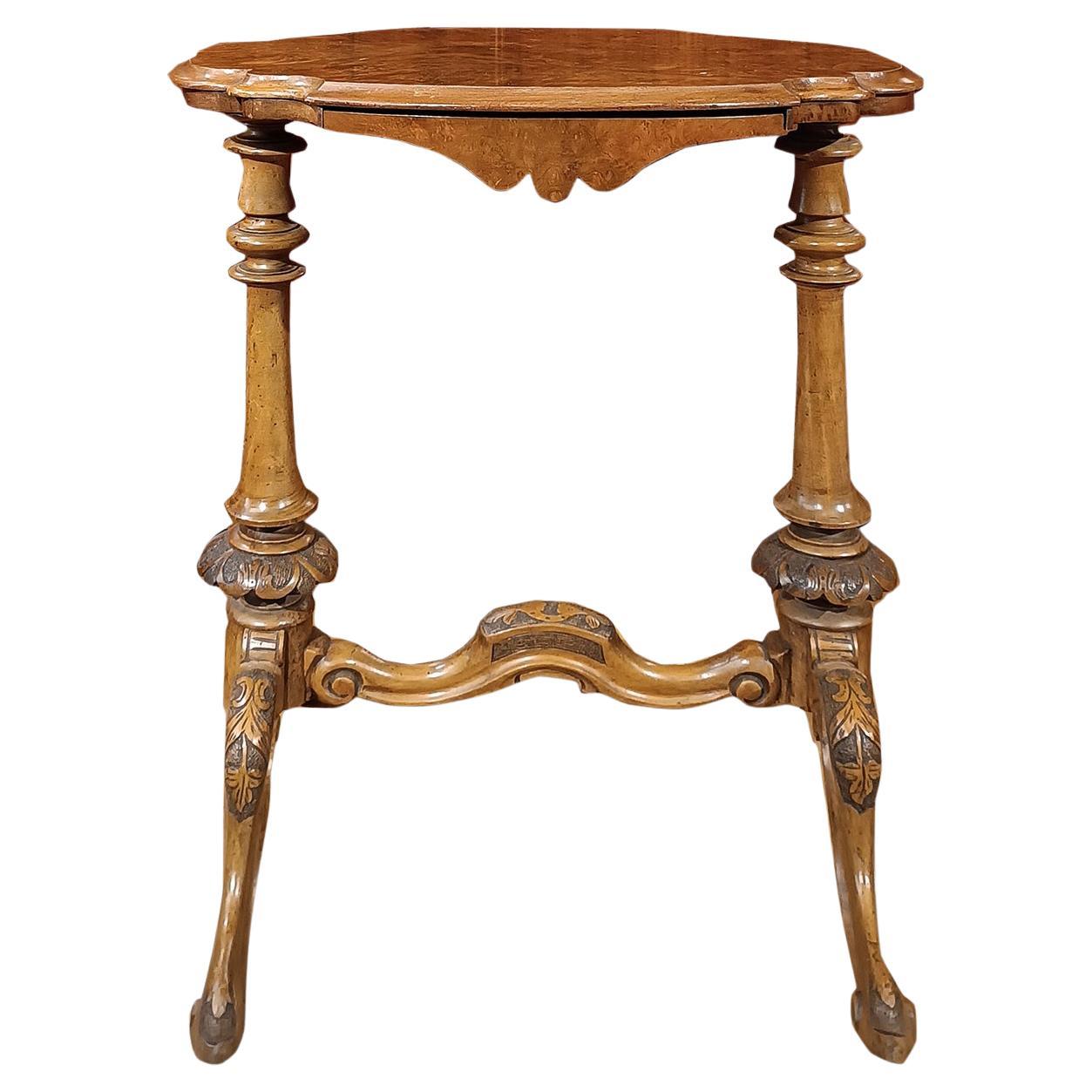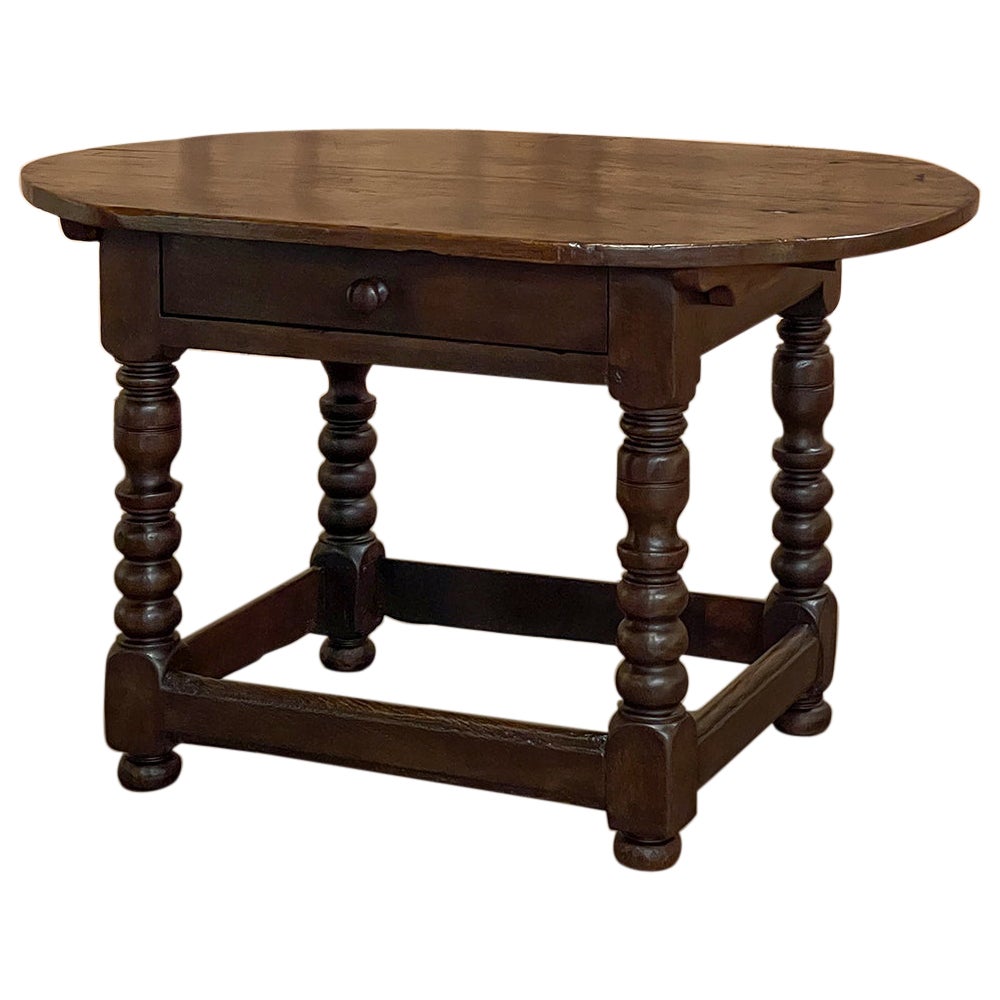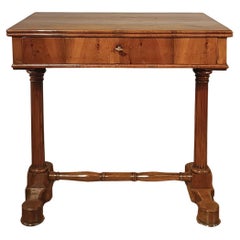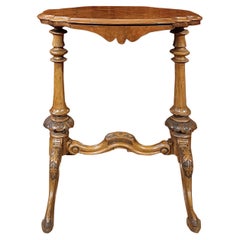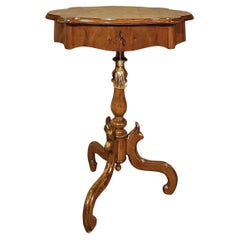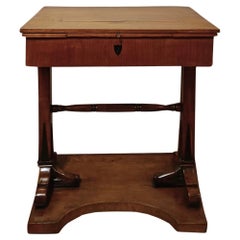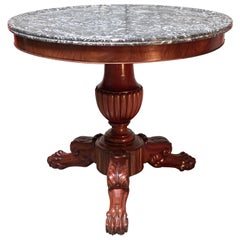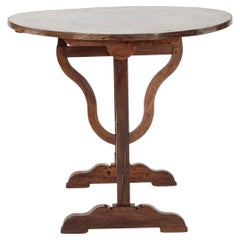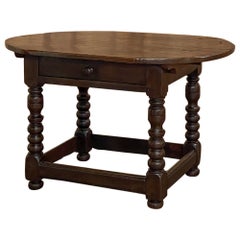Items Similar to EARLY 19th CENTURY CHARLES X COFFEE TABLE IN WALNUT
Want more images or videos?
Request additional images or videos from the seller
1 of 13
EARLY 19th CENTURY CHARLES X COFFEE TABLE IN WALNUT
About the Item
Elegant coffee table in solid walnut with walnut root veneer, featuring a round top supported by a central hexagonal shaft, which ends with three feet with a single base adorned with charming decorative curls. This piece has an intriguing peculiarity: a secret under the top. In fact, by pulling an iron tab, an oval compartment opens, equipped with small dividers, ideal for storing and hiding small objects. Characterized by excellent manufacturing, the coffee table stands out for its elegance and refinement, capable of embellishing any environment with taste and charm. It is also hypothesized that its manufacture may have been created following a design by the architect Fantastici. Tuscan manufacture from the Charles X period, early 19th century (ca. 1820).
Measurements: H x DM 80 x 82cm
- Dimensions:Height: 31.5 in (80 cm)Diameter: 32.29 in (82 cm)
- Style:Charles X (Of the Period)
- Materials and Techniques:
- Place of Origin:
- Period:
- Date of Manufacture:1820
- Condition:Wear consistent with age and use. We remind you that for exportation, authorization from the Fine Arts is required.
- Seller Location:Firenze, IT
- Reference Number:1stDibs: LU7189241661462
About the Seller
3.7
Vetted Professional Seller
Every seller passes strict standards for authenticity and reliability
1stDibs seller since 2022
31 sales on 1stDibs
Typical response time: 10 hours
- ShippingRetrieving quote...Shipping from: Firenze, Italy
- Return Policy
Authenticity Guarantee
In the unlikely event there’s an issue with an item’s authenticity, contact us within 1 year for a full refund. DetailsMoney-Back Guarantee
If your item is not as described, is damaged in transit, or does not arrive, contact us within 7 days for a full refund. Details24-Hour Cancellation
You have a 24-hour grace period in which to reconsider your purchase, with no questions asked.Vetted Professional Sellers
Our world-class sellers must adhere to strict standards for service and quality, maintaining the integrity of our listings.Price-Match Guarantee
If you find that a seller listed the same item for a lower price elsewhere, we’ll match it.Trusted Global Delivery
Our best-in-class carrier network provides specialized shipping options worldwide, including custom delivery.More From This Seller
View AllEARLY 19th CENTURY CARLHES X WALNUT TABLE
Located in Firenze, FI
Elegant coffee table in carved blond walnut. Originally designed as a work table, it can be used as a small desk or console. The fluted columns and the molded footrest give a touch o...
Category
Antique Late 18th Century Italian Charles X End Tables
Materials
Nutwood
FIRST HALF OF THE 19th CENTURY CARVED WALNUT COFFEE TABLE
Located in Firenze, FI
Elegant coffee table in walnut root and carved solid walnut. The oval and curved top is equipped with a practical hidden drawer, ideal for storing small objects. The legs, finely tur...
Category
Antique Early 19th Century English End Tables
Materials
Walnut
EARLY 19th CENTURY BIRCH OPENING TABLE
Located in Firenze, FI
Splendid table in light birch wood, finely carved. The table is characterized by an opening top with a lock on the front, inside which there are practical compartments for storing sm...
Category
Antique Early 19th Century Austrian End Tables
Materials
Birch
EARLY 19th CENTURY SMALL WORKING TABLE
Located in Firenze, FI
This splendid and refined cherry working table, of Tuscan manufacture from the early 19th century, is a unique piece that can also be used as a small desk. Its ancient function was t...
Category
Antique Early 19th Century Italian End Tables
Materials
Wood, Cherry
EARLY 19th CENTURY GILDED WOOD TEA TABLE
Located in Firenze, FI
This tea table, made of fine carved wood and subsequently gilded with pure gold leaf, is an authentic masterpiece of design and craftsmanship. Characterized by a round fabric top, el...
Category
Antique Early 19th Century Italian End Tables
Materials
Crystal
EARLY 19th CENTURY CHARLES X INLAID "SAIL" TABLE
Located in Firenze, FI
Elegant walnut "sail" small table, enriched with refined fruitwood inlays. The decorative inlays, which stand out for their great elegance, adorn the top, legs and shaft of the table...
Category
Antique Early 19th Century Italian Charles X Dessert Tables and Tilt-top...
Materials
Fruitwood, Walnut
You May Also Like
Early 19th Century French Charles X Mahogany Pedestal Table with a Marble Top
Located in Dallas, TX
An early 19th century French Charles X mahogany table with a dark grey and white veined marble top. This handsome, sculptural table has a car...
Category
Antique Early 19th Century French Charles X Center Tables
Materials
Marble
19th Century Walnut Wine Table
Located in Houston, TX
Walnut folding vendange table. France, circa 1870. Measurements: H: 28" W: 31.75"
Category
Antique 19th Century French End Tables
Materials
Walnut
19th C. French Charles X Restoration Period Sewing Stand Work Table
Located in Forney, TX
A scarce period Charles X (1818-1834) French Restoration mahogany travailleuse sewing (thread stand - side table - jewelry dressing table) with light, warm, beautifully aged patina.
Born in France in the early 19th century, almost certainly Parisian work, exquisitely hand-crafted, this exceptionally executed example features ornate gilt bronze ormolu mounts, escutcheons, and elaborate gilt metal trim. Having a highly figured light mahogany hinged lid top, lifting open to reveal a striking finished interior with divided compartments and original inset mirror plate. The conforming rectangular case fitted with a faux drawer front over a dovetailed drawer with sectioned interior. Elegantly rising on oval-shaped medial shelf stretcher-joined curvacious legs.
Dimensions (approx):
27" High, 20" Wide, 13.5" Deep
Stunning light almost blonde antique mahogany coloring and mellow warm tone, superb wood grain detail, and charming, beautifully aged patina over the whole. Great shape overall. Retaining original antique character marks, wear consistent with age and indicative of minimal use, nothing that detracts from the aesthetics or functionality, but only adds to the overall authenticity, refined elegant warmth, luxurious sophistication, and cozy unpretentious rustic elegance.
Delivered cleaned, hand waxed, polished French patina finish, ready for immediate use and generational enjoyment!
What is Charles X style:
The comte d’Artois – or Charles X - was the son of the dauphin Louis-Ferdinand de Franc and Marie-Josèphe de Saxe. He succeeded his two brothers Louis XVI and Louis XVIII and became the King of France in 1824. Thirty years after the French Revolution, he wanted to embody the return of monarchy and became the leader of the catholic party . As the previous kings, he was crowned in 1825 but he was soon overthrown by the revolution in July, 1830, called "Trois Glorieuses". He left then for England, Scotland, Prague and Istria where he died in 1836.
Charles X style lasted from 1818 to 1834 and happened during the Bourbon Restoration (French Restoration). This style did not replace totally the style of furniture from the French Empire but it was different from the formalism in the Napoleonic era, during which strictness and simplicity were inspired by Greco-Roman art. Indeed, artistic fields flourished. In terms of furniture, this renewal was suggested by the softening of shapes. Even though the simple aspect from the French Empire was still visible, shapes became curvier with volutes and arabesques. Another distinction is the loss of the massive aspect of furniture and the decrease of dimensions in order to decorate smaller appartments. Handling ability and comfort were key-words in the making of furniture. Apartments had essential elements such as chests of drawers, big rounded tables in the dining room, desks or secretaries, armoires and even dressing tables, comfortable fainting couches in the living room, small tables, pedestal tables, as well as gondola chairs. The wavy aspect of the latters certainly represent Charles X style the best.
One of the most emblematic features of this style is the use of bois clairs – light woods in warm blond tones - and indigenous woods that are varnished in order to highlight the grains. Bird's-eye maple, ash trees, plane trees, yew trees, beech trees, olive trees and cedar trees were most likely to be used. Indeed, at the beginning of the 19th century dark woods were hard to find. In 1806, the Napoleon’s Continental System was established in order to ruin the United Kingdom by preventing the country from any business with the rest of Europe. Therefore craftsmen had to find alternatives from mahogany which was the most commonly used material at this time. After 1815, the import of wood was even more difficult because of peace treaties and the European political situation, which contributed to the popularity of the bois clairs and indigenous woods. The furniture was often decorated with fine inlays made out of dark wood representing foliage, which contrasted with the veneer. Even though these patterns can look like bronze decorations from the Empire era, they were far more simple and did not represent any military or mythological attributes. On the tables, trays were sometimes made out of marble as in the French Empire, but it was often put aside and inlaid veneer, Verre Eglomisé – a type of glass with a mirror finish –, mirror or porcelain from Sèvres or Paris were more likely to be used.
Decorative elements from the Monarchy were highly appreciated again as they suggested luxury. Indeed, marquetry work was particularly fashionable - Boulle marquetry thrived around 1820 as the works of the Levasseur family can show. In the same way, draperies and trimmings referred to the monarchist splendour. Fabrics were often white – the traditional colour of the Bourbons – or light coloured as oppposed to the typical green from the Napoleonic era.
One of the most symbolic figures from this period of time might be Jean-Jacques Werner (1791-1849), a cabinetmaker who worked for prestigious clients such as the Duchesse de Berry who was Charles’s step-daughter. His works can be seen at the Musée des Arts Décoratifs and at the Grand Trianon in the Palace of Versailles. The duchess’s appartments situated at the pavillon de Marsan and at the Palais de Saint Cloud illustrate Charles X style the best with furniture made out of bois clairs and ornamented with dark wood patterns or fine gold decorations.
Chales X style allows a transition between the sobriety of the Empire style and the abundant aspect of Louis-Philippe style. The gothic style started at this time through the "style à la cathédrale", inspired by religious architecture, which thrived from 1827 to 1830. Indeed, at the beginning of the 19th century, Romanticism put the spotlight on the Middle Ages. Cabinetmakers were not inspired by the medieval furniture but rather by architectural elements of churches and cathedrals. For instance the backs of chairs were decorated with arches shaped like rib and serration. In the same way, before Charles X abdicated, pieces of furniture were made out of dark woods – such as mahogany, which was used again in France – and were inlaid with light wood. Romanticism also influenced the layout of furniture in appartments to suggest movement through a mix of various styles, various shapes and various sizes, as opposed to the static aspect of Neoclassicism. The start of industrialisation and mechanisation also influenced this style as early technical developments led to the production of pieces of furniture in series.
Credit:
Marc Maison
Bibliography:
FANIEL Stéphane (Dir.), Le Dix-neuvième Siècle Français, Collection Connaissance des Arts, 1957, Hachette
SASSONE, Adriana Boidi, Furniture from Rococo to Art Deco, 2000, Evergreen
--
Extremely versatile:
As warm and attractive as it is useful, this remarkable antique table having the ideal size and small proportions for a variety of different uses, including as a side table, accent or occasional table, tall sofa...
Category
Antique Early 19th Century French Charles X End Tables
Materials
Bronze, Ormolu
Early 19th Century Dutch End Table
Located in Dallas, TX
Early 19th century Dutch end table was fashioned from solid planks of old-growth oak to literally last for centuries! The thick plank top fea...
Category
Antique Early 19th Century Dutch Rustic End Tables
Materials
Oak
$2,384 Sale Price
20% Off
19th Century French Walnut Side Table
Located in High Point, NC
Fabulous 19th century walnut side table from France with a beveled edge around the top, following down to a simple apron with a lower molded edge and a single drawer in the front. th...
Category
Antique 19th Century French Louis Philippe Side Tables
Materials
Walnut
Directoire Mahogany Trestle Table, Early 19th Century
Located in Spencertown, NY
Directoire mahogany trestle table, early 19th century. An octagonal top with lower shelf table.
Category
Antique Early 19th Century French Directoire Desks
Materials
Mahogany
$3,500 Sale Price
30% Off
